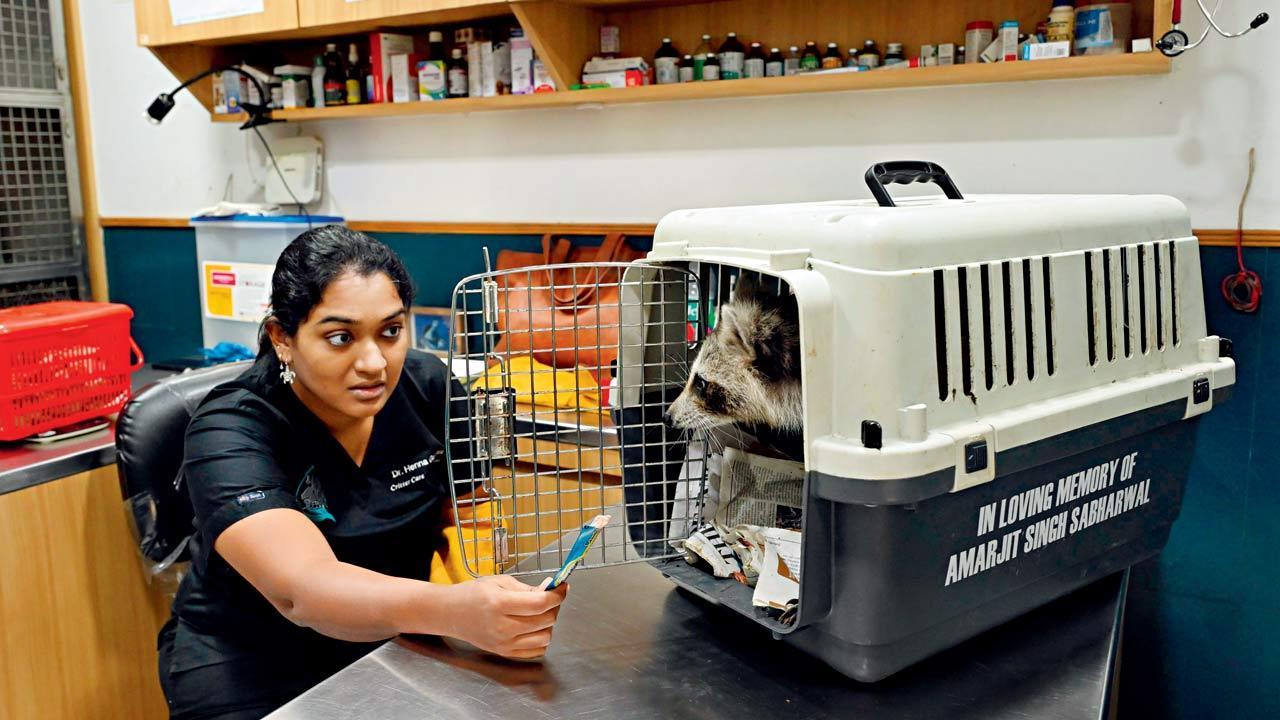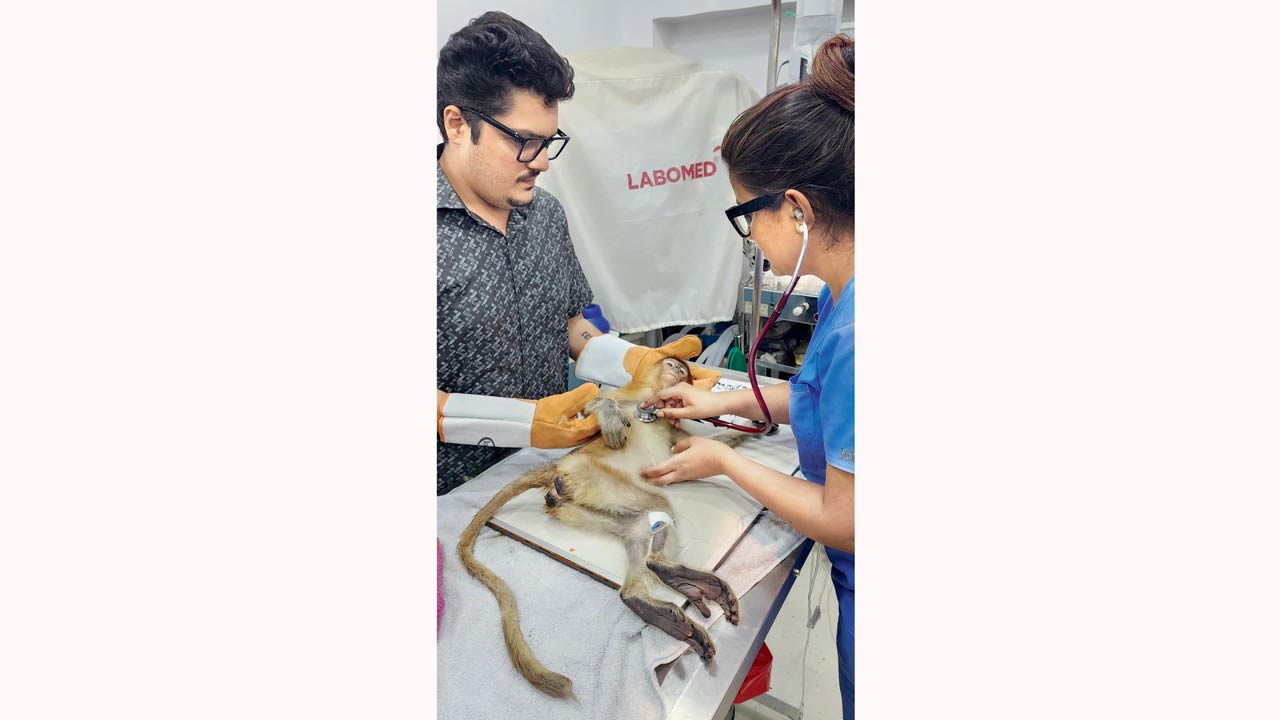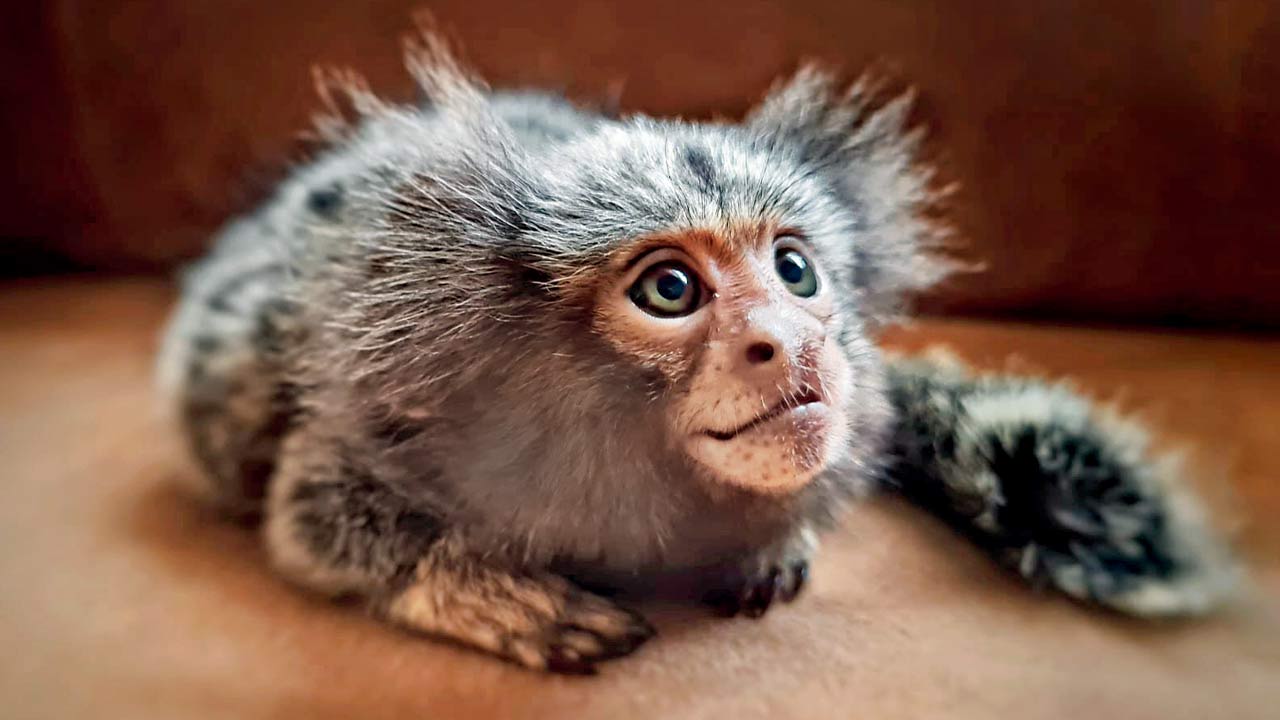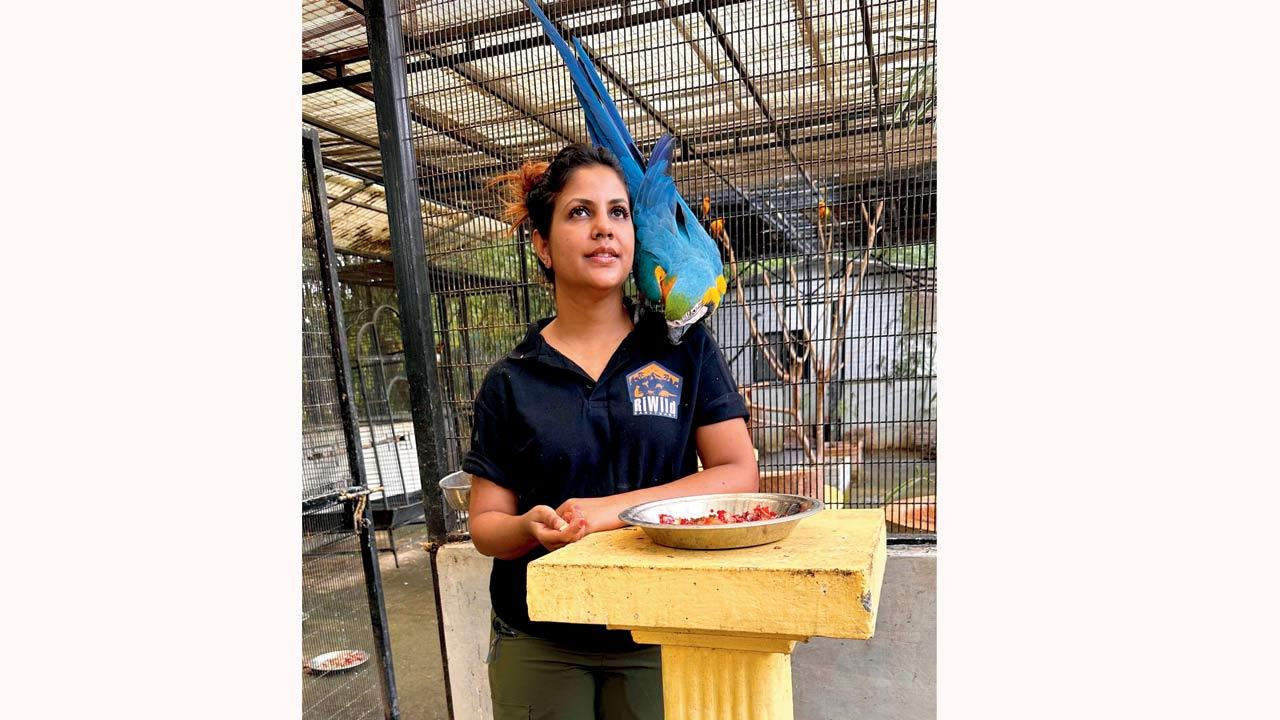A raccoon suspected to hail from the US strayed into Palghar last New Year’s Eve and could’ve landed in the lap of traffickers but for animal rights activists. What happens to exotic animals after seizure and what goes into their painstaking rehab?

Jimmy, a raccoon rescued from a cargo ship, during a medical examination by Dr Henna Ganjwala at Critter Care veterinary clinic in Andheri West. Pics/Satej Shinde
Jimmy the raccoon doesn’t belong in India. In fact, it looks like he might not belong anywhere. Jimmy landed in Mumbai on New Year’s Eve last year, as a suspected stowaway on a cargo ship ferrying a foreign consignment of tires. “Raccoons are not native to India. When the workers opened the consignment in Palghar, they found an animal inside that they had never seen before. After taking a look, we confirmed that it was a raccoon and took custody of it,” says Ritu Sharma, 29, a volunteer with the NGO RAWW, who has been overseeing the care of the exotic animal at the organisation’s facility on the outskirts of Thane.
ADVERTISEMENT
Rehabilitating Jimmy has not been an easy task. He had arrived dehydrated and underweight, with tattered fur. Sharma began by taking him to an exotic animals’ vet so he could be stabilised. The next step was figuring out how to feed him in a way that would ensure optimum health and that he does not get dependent on humans for food. All this costs time, effort and money. His care over the past six months alone has cost upwards of R1.8 lakh. These are not exactly things that Sharma, who has a full-time job as a linguist, has in unlimited supply. Neither can she do it forever—there are legal restrictions, and she’d much rather Jimmy have a shot at freedom in the wild one day.
 This month, this female proboscis monkey was rescued from traffickers at Mumbai airport. She was stuffed into a suitcase and smuggled here from Thailand. She is in the care of RAWW for now, being treated for dehydration and diarrhoea before her anticipated repatriation. Her medicines and imported feed cost Rs 10,000 per week
This month, this female proboscis monkey was rescued from traffickers at Mumbai airport. She was stuffed into a suitcase and smuggled here from Thailand. She is in the care of RAWW for now, being treated for dehydration and diarrhoea before her anticipated repatriation. Her medicines and imported feed cost Rs 10,000 per week
But where will Jimmy go? As an exotic species that is not native to India, he can’t be released in the wild, as he may not survive. Releasing the raccoon also bears the risk of it becoming an invasive species, as it happened in Japan recently. A cartoon about a raccoon called Rascal had made the animal an immensely popular pet, but many abandoned their raccoons on realising they are not easy companions. The raccoons proliferated and turned into an invasive species, causing agricultural damage worth . 2,200,000 (Rs 23.8 crore) in 2022 alone.
Neither can such species be handed over to citizens to adopt as they require specialised care.
 Michael the marmoset needs round-the-clock medical attention because of a metabolic bone condition, as well as liver cancer
Michael the marmoset needs round-the-clock medical attention because of a metabolic bone condition, as well as liver cancer
One solution is to send Jimmy back to where he came from. But that route is riddled with hurdles. Based on accounts from the cargo ship workers, rescuers suspect the raccoon got into the vessel by accident and may originally have come from the US. “But we have no papers to establish this. There are international treaties under which exotic animals can be sent back to the country of origin, but there are many technicalities and it doesn’t always work out,” says Sharma.
There’s a big question mark hanging over their heads—will the US be willing to take the raccoon, with the species also considered a pest there? But it’s either repatriation or a lifetime in captivity at a zoo.
 Dr Rina Dev with one of her favourite birds, Tequila the blue and gold macaw, at Riwild, the exotic birds’ sanctuary she runs at Karjat
Dr Rina Dev with one of her favourite birds, Tequila the blue and gold macaw, at Riwild, the exotic birds’ sanctuary she runs at Karjat
It is the same story for thousands of exotic animals that are trafficked to India every year, ranging from exotic birds like African grey parrots and lorikeets, to primates like marmosets and proboscis monkeys, and even larger animals like kangaroos.
“We are seeing such trafficking cases every two to three months, and the frequency has risen in the last couple of years. Last month, officials caught two fliers from Thailand at Mumbai airport who had stuffed three monkeys and seven birds in their suitcases. Three of the birds were found dead,” says Yogesh Warkad, deputy director of the Wildlife Crime Control Bureau, Mumbai. Despite the deaths, this is a story with a happy ending. “The surviving animals were successfully repatriated to Thailand after receiving medical attention,” he says. “The animals that don’t get repatriated will be housed at a zoo registered under the central zoo authority. They will live their life in captivity,” he adds.
But before they are sent to a zoo, the animals’ survival depends on wildlife rehabilitators, who painstakingly nurse them back to health. Wildlife rehabilitation is a full-time job on its own, but most people who do it are volunteers who have full-fledged professions and still somehow take out the time to save the animals. These volunteers empty their own pockets to ensure the critters get everything they need, and give them a better shot at life. After all, what is the point of rescuing an animal from a trafficking ring or a neglectful owner if it ends up dying sick and lonely?
“Abroad, this is a salaried job. Here, we have to do other jobs so we can pay for this work. Some people reach out to their friends and acquaintances for funds to keep the work going,” says Sharma.
“Rehabilitating exotic animals is very different from rehab for any other animal. These animals are very delicate and are out of their natural environment. They are trafficked to India in inhumane conditions, and many arrive on the verge of death,” says Pawan Sharma, founder of RAWW.
“We have to feed them species-appropriate food, and ensure they get medical care from a vet who has expertise with exotic species. It requires extensive infrastructure, expertise and a support system to be able to do this kind of work,” says Pawan, adding that this requires a lot of funding. NGOs like RAWW get a lot of their funding from regular people, he says, adding that most donors are fellow rescuers or people who love animals.
Sometimes the animals are very ill and need round-the-clock attention. Bryan, a logistics consultant, has been fostering a marmoset, Michael, for six months. The tiny primate has a metabolic bone disease and cannot walk. Instead, he drags himself by his forearms. “He was abandoned as a newborn. He was on the brink of death but [exotic animals’ vet] Dr Rina Dev saved him. But a month ago, we discovered that he has liver cancer. So now we are trying to figure out what the path ahead is for him,” he says. Michael’s species requires calcium supplements because they cannot synthesise the mineral in captivity. “In the wild, he would have got calcium from bird eggshells. But in captivity, especially with his bone condition, he needs expensive supplements,” he adds.
Before this, Bryan was fostering an African grey parrot with a severe lung issue. The bird died within months. “It is heart-wrenching when this happens. With Michael, I’m not sure what lies in his future, but I remind myself that at least I have given him some comfort, no matter how long he lives,” says Michael.
Michael’s vet, Dr Dev, who runs a veterinary clinic in Bandra, also runs an extensive rehab operation for exotic birds, called Riwild, in Karjat. She has around 60 birds at the facility, ranging from blue and gold macaws, to African grey parrots, many of whom will be lifetime residents at the facility. Supporting the facility takes close to R1 lakh per month, and it is entirely self-funded, she says.
“Caring for exotic animals is expensive and complex. As an exotic vet practising for 18 years, I am blessed with medical knowledge and expertise and income from my clinic, otherwise I don’t think I could have sustained rehab work,” says Dr Dev, who goes to the Karjat facility every Saturday and Sunday and oversees every detail of the birds’ rehab, including growing mealworms that they need to be fed.
But not everyone can work in rehab for exotic animals, because there are very particular challenges with it, Pawan emphasises. “Apart from food and medical treatment, if there is a wild animal involved, we need to ensure it does not imprint or get dependent on humans. This needs a lot of experience and expertise, he says.
He also feels that there is a lack of infrastructure, such as large facilities that are specifically equipped to house and care for exotic species. “However, with the new amendment in the Wildlife Protection Act in 2022, it now also extends protection to all exotic species that are in the international CITES and IUCN lists. This gives these animals similar protection that the tiger enjoys. We’re hoping with this, the government may also have plans for rehab facilities geared towards exotic species,” he concludes.
Whom to call if you see an exotic animal in distress
. Dial 1926, the toll-free helpline of the forest department, and report the exotic animal
. One can only foster or rehab an exotic animal with the permission of the forest department. Otherwise you will be held in violation of the law
 Subscribe today by clicking the link and stay updated with the latest news!" Click here!
Subscribe today by clicking the link and stay updated with the latest news!" Click here!







